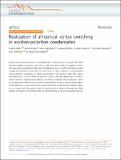Realization of all-optical vortex switching in exciton-polariton condensates
Abstract
Vortices are topological objects representing the circular motion of a fluid. With their additional degree of freedom, the 'vorticity', they have been widely investigated in many physical systems and different materials for fundamental interest and for applications in data storage and information processing. Vortices have also been observed in non-equilibrium exciton-polariton condensates in planar semiconductor microcavities. There they appear spontaneously or can be created and pinned in space using ring-shaped optical excitation profiles. However, using the vortex state for information processing not only requires creation of a vortex but also efficient control over the vortex after its creation. Here we demonstrate a simple approach to control and switch a localized polariton vortex between opposite states. In our scheme, both the optical control of vorticity and its detection through the orbital angular momentum of the emitted light are implemented in a robust and practical manner.
Citation
Ma , X , Berger , B , Assmann , M , Driben , R , Meier , T , Schneider , C , Höfling , S & Schumacher , S 2020 , ' Realization of all-optical vortex switching in exciton-polariton condensates ' , Nature Communications , vol. 11 , 897 . https://doi.org/10.1038/s41467-020-14702-5
Publication
Nature Communications
Status
Peer reviewed
ISSN
2041-1723Type
Journal article
Description
This work was supported by the Deutsche Forschungsgemeinschaft (DFG) through the collaborative research center TRR142 (grant No. 231447078, project A04) and Heisenberg program (grant No. 270619725) and by the Paderborn Center for Parallel Computing, PC2. X.M. further ackowledges support from the NSFC (No. 11804064). The Würzburg group acknowledges support by the state of Bavaria.Collections
Items in the St Andrews Research Repository are protected by copyright, with all rights reserved, unless otherwise indicated.

